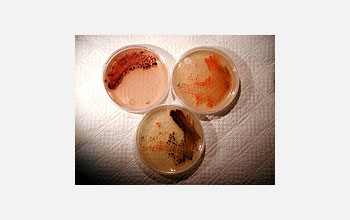Multimedia Gallery
Three species of bacteria from genus Salinospora
Three species of bacteria from the genus Salinospora growing on agar culture plates.
These bacteria, which had never been observed until 2001, are major microbial inhabitants in marine sediments from the deep oceans. It can be estimated that perhaps 10,000 species of these microbes will ultimately be harvested from the marine environment. This is important because testing these microbes for their affects against diseases and cancer has shown that they, like the bacteria in soil, produce antibiotics and anticancer agents. Because these are genetically and environmentally unique--and have never been seen or studied before--they represent an enormous resource for the discovery of new drugs. For example, one strain of these bacteria has been shown to produce a very powerful anticancer agent called salinosporamide A. Many of the drugs that have been in use for a long time have developed a resistance and are no longer as effective. We are in need of an entirely new group of antibiotics. The massive areas encompassed by the deep oceans represent a new biomedical resource of massive proportion.
This image was taken during research conducted by William Fenical, a professor of oceanography at the Scripps Institution of Oceanography, and his team. Fenical's many research projects can require support from both the National Science Foundation (NSF) and the National Institutes of Health (NIH). NSF support is used for the environmental exploration side of his work and then, for example, if a project turns from fundamental marine chemical ecology to biomedicine, the research then receives support from NIH (NSF does not support direct biomedical research).
Credit: Valerie Paul
Images and other media in the National Science Foundation Multimedia Gallery are available for use in print and electronic material by NSF employees, members of the media, university staff, teachers and the general public. All media in the gallery are intended for personal, educational and nonprofit/non-commercial use only.
Images credited to the National Science Foundation, a federal agency, are in the public domain. The images were created by employees of the United States Government as part of their official duties or prepared by contractors as "works for hire" for NSF. You may freely use NSF-credited images and, at your discretion, credit NSF with a "Courtesy: National Science Foundation" notation.
Additional information about general usage can be found in Conditions.
Also Available:
Download the high-resolution version of the image. ()
Use your mouse to right-click (Mac users may need to Ctrl-click) the link above and choose the option that will save the file or target to your computer.

